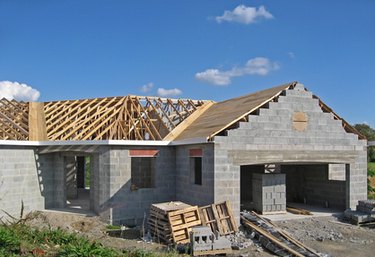
Contractors elect to fill the hollow openings or voids in concrete blocks (sometimes referred to as grouting) after they are stacked or laid to achieve a stronger wall, one with properties nearly identical to a poured concrete wall.
Considerations
Video of the Day
For smaller projects, and those poured by hand, some type of funnel (typically constructed out of plywood) matching the size of the openings in the concrete blocks is necessary to facilitate pouring the mixture into the block cells. The mixture will also have to be vibrated by hand to eliminate any voids. Pumpers are available for larger projects.
Video of the Day
Function
Concrete block cells can also be filled with insulation offering a higher R-value. Installation of vertical and horizontal reinforcing steel in the hollow block openings strengthens foundation walls constructed of concrete block. Cells can also be filled with other materials to reduce noise, reduce water migration, improve fire rating or reduce heat transmission.
Misconceptions
The same ingredients used in poured concrete (Portland cement, sand, gravel and aggregate) are the same used to make concrete block with the exception of the gravel size. When a wall of stacked concrete block voids are filled with a cement-based mortar or concrete containing small pea gravel, its value becomes almost indistinguishable from a poured concrete wall.